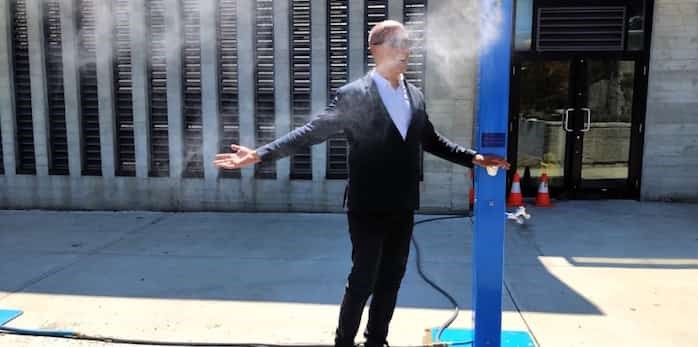At best, you’ll have to contend with a wicked sunburn and moderate dehydration.
The worst-case scenario is death. And lots of it.
Officials from the city, park board and Vancouver Coastal Health briefed reporters Thursday afternoon on a series of measures that will help Vancouverites beat the heat, before the opposite happens and brings devastating consequences.
A series of misting stations and water fountains are being installed in high-pedestrian areas in the next two weeks, air-conditioned community centres and libraries are opening their doors to the masses and trees are being planted in three key areas — the Downtown Eastside, False Creek Flats and Marpole — to increase tree cover and shade.
Clear air filtration units will be introduced into city-owned non-market housing locations when air quality advisories are issued and cleaner air rooms are being piloted at the Carnegie Community Centre, the Gathering Place, Mount Pleasant Community Centre and the Central Library.
All of this comes while huge swaths of western Europe burn uncontrollably and after 1,000 lightning strikes hammered the Okanagan Monday, starting 10 wildfires.
“Heat can kill,” said Vancouver Coastal Health medical officer James Lu.
That very scenario played out 10 years ago this week. The summer heatwave spanning late July and early August killed an estimated 200 people in B.C., with the majority of those deaths — about 120 — occurring in Metro Vancouver.
The last five years have been the hottest on record across the globe. Climate forecasts ranging out to 2050 are less encouraging: the number of days with 25 C heat or hotter will double in 30 years and the high water mark for extreme heat will jump from 33 to 37 C.
In the local context, the city’s extreme weather response is triggered any time Environment Canada issues a heat warning — the thresholds for it to take place include daily temperatures in excess of 29 C and nightly lows that remain above 16 C for two consecutive nights.
Lu noted those conditions can kill anywhere from two to four people daily and a five per cent spike in mortality rates can be expected.
Seniors, the homeless, kids and those with heart and respiratory conditions are most vulnerable. It’s to that point that the need was stressed for vigilance: check on family, neighbours and anyone else who may be vulnerable when the mercury rises.
“That’s how we make our city and our neighbourhoods resilient to climate change and to heat issues — when we are willing to look out for those who are around us, to make sure that they are safe as well,” Lu said.
The tell-tale signs of sunstroke and heat exhaustion include thirst, confusion, perspiration, fatigue, dizziness and muscle cramps. Passing out from heat exhaustion requires immediate medical care.
The seasonal reminders to keep pets out of cars was also touched on Thursday. Any time that happens, the B.C. SPCA is the agency to call. Off-leash parks in Vancouver with access to water for pets include New Brighton Park, Crab Park at Portside, John Hendry dog park, Sunset Beach, Hadden Park and Spanish Banks.
The park board is also asking residents to help care for the 145,000 trees found on boulevards and streets. Signs of heat stress include wrinkled or brown leaves, or a lack of foliage altogether. Residents are asked to water trees when those signs are noted, and doing so is permitted under Metro Vancouver water restrictions.
The Environment Canada forecast for the next week includes temperatures in the mid to low 20s.
A full list of locations and hours for local cooling centres is online HERE




